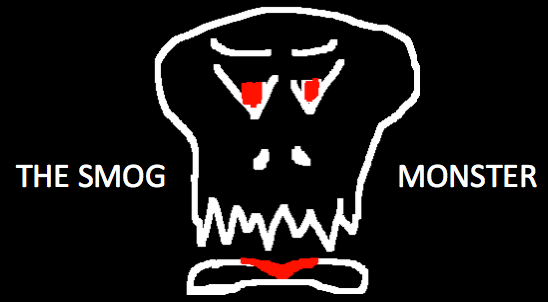
No one loves a polluted Beijing quite like foreign editors. The first time the smog swept through, two and a half weeks ago, lots of overseas publications were caught off guard and slept on the story, which is why we saw articles about China’s “Airpocalypse” up to five days after the skies had cleared up.
Determined to never miss an easy story again, however, foreign editors are all over this week’s pollution like roaches on guano. Here’s a very compendious list of non-wire stories about Beijing’s air — weather stories, basically:
“Beijing choking on hazardous smog – again.” (This Just In blog, CNN)
“An economic death sentence.” (Fortune)
Pollution. (WSJ)
Pollution! (NBC News)
POLLUTION! (BBC)
More CNN! (CNN)
“Smog city.” (Daily Mirror)
Once again, with feeling: “Once again, air pollution in Beijing is literally off the charts.” (Newser)
Just a gallery. Words are for the birds. (Getty via Global News)
Beijing recommends the young and old stay indoors. Breaking? (Bloomberg News)
Here’s a video. Warning: it autoplays. Maybe you shouldn’t click. (The Age)
And finally, this headline: “Salt Lake City Smog Approaches Beijing Levels.” C’mon! (American Geophysical Union)
Again, these are only the non-wire stories, and AP, Reuters, AFP all have write-ups that have been picked up by ABC, CBS, Fox, NBC, Guardian, Telegraph, etc. Huffington Post will surely provide their “take” three days later.
We do appreciate that some stories have attempted to push the conversation. For example:
“China’s Pollution: The Birth Defect Angle.” (James Fallows, The Atlantic)
Profit from pollution! (The Daily Reckoning)
The possibility of a clear air act for China. (Green blog, NY Times)
More pieces like these can go a long way toward advancing the conversation. China — and Beijing specifically — is polluted for a number of reasons, including population (especially this reason; want to guess China’s emissions per capita?), economic growth, lack of arable land, geography, etc. Surely you popular media folk can help steer the discussion beyond API readings? And yet, your contribution to public discourse is shock-and-awe pieces, one-liners (“pollution that can be seen from space!”), furrowed eyebrows on television reporters who wipe soot off car windows… The Daily Show’s around for that. At the very least, you can stop acting like this is the first time smog has settled over a Chinese city, or will be the last.




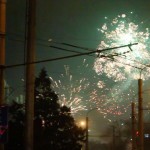



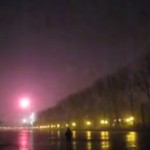







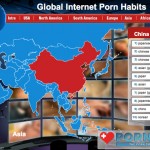



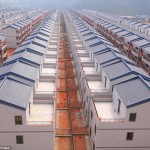



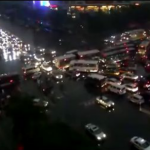




















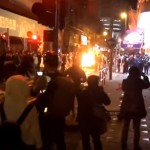

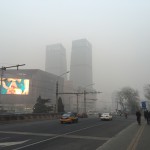

Beijing is a geographic bowl, there’s the siberian anti-cyclone during the winter, and oh yea, it’s winter…. everyone’s burning coal to keep warm. Combine these things along with the low pressure system which kills the wind and this is what we get. And as someone who has been here a very long time, it used to be far worse. This “unimaginable” pollution was par for the course all winter long less than a decade ago.
Of the various causes of pollution I’d say domestic coal burning is about the only one they have a shot at in the medium term.
To my (laymans) eyes, the three most important policies should be.
-Massively curbing car use. Aim to make the main cities as car free as possible, couple this with very rigorous emissions standards (no more soot beltching blue lorries). Not going to happen due to cultural resistance; Not only will any policy to this end be resented and restisted it will be so by the rich and powerfull who can’t be trodden on.
-Industrial emission control. Every powerplant and steel mill needs to install and USE Flue-gas desulfurization (FGD),at the very least. -I’d be fairly certain that corruption would knobble this before it even began.
-Domestic emission control. Tax small coal purchases, subsidize alternative heating sources and in particular insulation.
Long term, i’ve no idea. Spanish flu?
What is guano?
Guano is the Quechua wanu word meaning “dung”, commonly used for cave-dwelling bats, but it can also be used for sea-birds or seals. I must say, if you spent a little less time commenting on web forums and a little more time watching Ace Ventura: When Nature Calls, we wouldn’t have these embarrassing incidents.
Bingo. That’s how I know what it means. That’s also how I know that it’s delicious!
But, but, but, Anthony. Didn’t you post a whole bunch of air pollution blog posts without advancing anything?
This winter has been very unusual in two respects.
#1 – the Siberian winds which normally come howling out of the north for most of the winter and blow the smog away have been largely non-existent this year.
#2 – Beijing has been much warmer and more humid than normal. Normally at this time of the year the highs are between -5 and 0 and the lows between -15 and -10, with humidity around 20-30%. Instead, this year the highs have been between 0 and +5 and the lows between -10 and -5, with humidity this week in the 80-90% range.
I havn’t even had to wear my heavy winter coat this year, instead walking half an hour to/from work every day wearing nothing but a thermal long-sleeve undershirt, a turtleneck, scarf/hat/gloves, and a windbreaker.
Yep, it has definitely been more humid this year as well. Not nearly as much static from everything you normally get in winter. More humidity that just sits there and hello fog! Also, if you pay attention to numbers during and immediately after rain storms, you’ll see that the embassy meters are misconfigured. All the others drop instantly with rain, the US meter tends to go up. On clear, but humid days, you also see this happen.
My personal opinion: This is part of a propaganda push. When there are bad PM 2.5 levels in the US, they go into endless explanation of what’s causing it, how the weather is to blame, etc. Over here, it’s everything but. The main difference between 10 and 2.5 monitoring is that water vapor and humidity had much less impact on the PM 10 filters, whereas it’s a known flaw of the 2.5s. There are methods to counter it, and it has to do with algorithms that take into account the humidity. However when you’re in a situation where pollution IS a known problem to begin with, the government is constantly bitched at and attacked and an outside government presents higher numbers, there’s not much you can do. The initial setup of 2.5 monitors showed that there were some corrections being made. The differences were blasted as misinformation on the Chinese side. Oddly, now they the same flaws are being ignored on both sides, the systems have similar results.
Actually, even in the US you can see this correlation on more remote test sites. Compare high PM levels with humidity maps and there’s a direct impact. Places that have no real reason for pollution at those levels show high levels. Places that have obvious pollution in person have been tweaked to minimize the official readings.
PM is monitored using filters and airflow control. At the end of each cycle, the various filters are weighed and due to the controlled airflow, you can calculate it. Manual stations have fewer issues. Automated ones… tend to be flawed.
Am I saying there’s no pollution? No, hell no. Yes, it’s not ideal. Yes, in fact on some days it’s downright bad. But it’s still better than before (there was no quantitative data as a baseline previously).
“My personal opinion: This is part of a propaganda push. ”
Bingo, again!
Not only that, but Americans who rage at China for “allowing” pollution don’t seem to understand that they directly benefit from pollution when they save at Wal-Mart!
God you two, get a freaking room! What a joke of a love-fest!
I just go by the severity of my headaches after being outdoors for an hour. Right now it’s a 340/500 on the Chackie-Meter.
Let’s justify and defend the massive amounts of pollution! Don’t forget that wonderful link that was on here the other day saying you can expect coal emissions to increase 250% or so in the next 20 years, not to mention that from cars. And we know as long as everything keeps falling apart they will keep building more to add more construction dust.